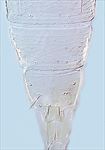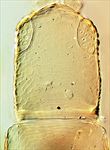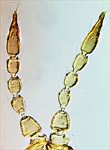
rufus female

rufus head & thorax

rufus antenna

rufus male tergites VII-X

stylifer antenna

stylifer female

stylifer head

stylifer_sternites V-VII

elegans antennae
Generic diagnosis
Female apterous. Head longer than wide, reticulate dorsally; maxillary palps 3-segmented; eyes small, with five pigmented facets; ocelli absent; ocellar I setae minute; postocular setae minute and irregular. Antennae 6- or 8-segmented, segment I without dorso-apical setae, II constricted at base, III and IV with sense-cones simple, VI with some microtrichial rows on both surfaces. Pronotum shorter than head, with no long setae. Mesonotum weakly defined from metanotum; two pairs of campaniform sensilla present. Metanotum not divided into scutum and scutellum; paired campaniform sensilla present and wide apart near posterior margin. Prosternal ferna slightly divided, with small tubercles along anterior margin; basantra membranous, without setae; prospinasternum broad and transverse. Mesosternum not defined from sternellum, with sternopleural sutures reaching anterior margin; endofurca without spinula. Metasternum with large fringe at posterior margin; endofurca without spinula. tarsi 1- or 2-segmented. Abdominal tergites distinctly reticulate, without ctenidia or craspeda; II–VII with two pairs or more setae medially in addition to three or four pairs near posterior margin, median campaniform sensilla near posterior margin; tergite VIII without comb; tergite IX usually with two pairs of campaniform sensilla, MD setae small; X with median split complete. Sternites without craspeda, with discal setae; sternites III–VII with three pairs of posteromarginal setae, II with two pairs; sternite VII with S1 setae in front of posterior margin.
Male similar to female, but smaller; tergite IX with two pairs of short, often stout, setae; sternites without pore plate.
Biological data
All of the species in this genus live on the leaves of Poaceae, and a key to the four species was provided by Palmer (1975).
Distribution data
Originally Palaearctic in distribution, some species of this genus have become widespread around the world in temperate regions.
Nomenclatural data
Thrips (Aptinothrips) Haliday, 1836: 445. Type species Thrips (Aptinothrips) rufa Haliday, 1836, by subsequent designation, Mound & Palmer, 1974.
Four species are placed in this genus (ThripsWiki, 2020), of which three are recorded from China:
elegans Priesner, 1924: 528.
rufus (Haliday, 1836: 445). (Thrips, Aptinothrips)
stylifer Trybom, 1894: 43.
Relationship data
Thripidae sub-family Thripinae: this is a diverse group involving more than 230 genera. This is one of 40 genera in the Anaphothrips group (Masumoto & Okajima, 2017). All of the species are wingless, thus making comparisons with other genera difficult.
References
Masumoto M & Okajima S (2017) Anaphothrips genus-group: key to world genera, with two new species and three new records from Japan (Thysanoptera, Thripidae). Zootaxa 4272 (2): 201–220.
Palmer JM (1975) The grass-living genus Aptinothrips Haliday (Thysanoptera: Thripidae). Journal of Entomology (B) 44 (2): 175–188.
ThripsWiki (2020) ThripsWiki - providing information on the World's thrips. <http://thrips.info/wiki/Main_Page>